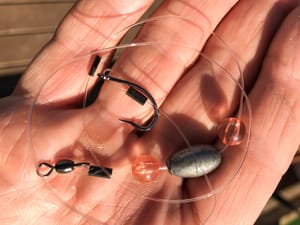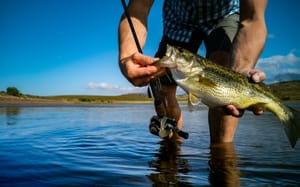Fishing is both a beloved pastime and a serious sport for many. Whether you're a seasoned angler or a novice, understanding the intricacies of your equipment is crucial for a successful outing. One of the most important pieces of gear is the fishing reel, and its size can greatly affect your fishing experience. In this article, we'll dive deep into the world of fishing reel sizes, ensuring you have the knowledge to choose the right reel for your next adventure.
Key Takeaways:
- Learn how fishing reel sizes are determined and what the numbers mean.
- Discover the importance of matching reel size to your fishing rod and target species.
- Gain insights into the different types of reels and their optimal size ranges for various fishing scenarios.
Deciphering Reel Size Numbers
When you're browsing through fishing reels, you'll notice a series of numbers that denote the size of the reel. But what do these numbers actually mean? Typically, these figures indicate the diameter of the spool. Smaller numbers, such as 1000 or 2000, refer to smaller reels suitable for light lines and smaller fish. On the other hand, larger numbers like 6000 or 8000 are indicative of reels that can handle heavier lines and larger fish.
The size of the reel you choose should correspond to the type of fishing you plan to do. For instance, a 1000-sized reel might be perfect for freshwater fishing for trout, while a 6000-sized reel would be more appropriate for battling larger saltwater species like tarpon or tuna.
Matching Reel to Rod and Target Species
It's not just about the fish you're after; the rod you use also plays a pivotal role in selecting the right reel size. A balanced setup is key to a comfortable and effective fishing experience. A small reel on a heavy rod, or vice versa, can lead to an awkward and inefficient casting and retrieval.
For example, if you're targeting small stream trout with a light action rod, a 2000-sized reel would typically offer the balance and finesse needed. Conversely, if you're aiming for larger species like salmon or steelhead, you might opt for a 4000 to 5000-sized reel paired with a medium-heavy rod to ensure you have the strength and capacity required for these powerful fish.
Spinning Reels: The Versatile Choice
Spinning reels are among the most popular types of fishing reels due to their versatility and ease of use. They come in a wide range of sizes, making them suitable for nearly any fishing situation. A 2500 to 3000-sized spinning reel is a great all-around choice for a variety of freshwater species, while larger 5000 to 8000 sizes are better suited for saltwater applications where larger, stronger fish are expected.
When selecting a spinning reel, consider the line weight and capacity you'll need. A larger spool allows for more line, which is beneficial when you need to make long casts or when fighting fish that tend to run.
Baitcasting Reels: Precision and Power
Baitcasting reels are favored by many experienced anglers for their precision and ability to handle heavier line and lures. These reels are typically categorized by their line capacity and gear ratio rather than spool diameter. However, the concept of size still applies; smaller baitcasting reels are used for lighter applications, while larger ones are designed for heavier fishing conditions.
For instance, a low-profile baitcasting reel might be ideal for freshwater bass fishing, where precision casting and control are paramount. In contrast, a larger round baitcasting reel would be the choice for big game fishing where power and line capacity are necessary.
Fly Reels: Matching the Hatch
Fly fishing reels are a different beast altogether. Their sizes are often matched to the fly line weight and the species you're targeting. A 3 or 4-weight fly reel would be suitable for small trout and panfish, while a 7 or 8-weight reel would be better for larger freshwater species like bass or for inshore saltwater fishing.
The size of the fly reel also affects its ability to hold enough backing, which is crucial when fishing for species that make long, powerful runs. Ensuring you have a reel with adequate backing capacity can make the difference between landing the fish of a lifetime and a heartbreaking break-off.
Lever Drag and Trolling Reels: Big Game Specialists
For offshore and big game fishing, lever drag and trolling reels are the go-to choices. These reels are built to handle heavy-duty fishing and are sized accordingly. They are often rated by line weight and capacity, with sizes that can handle line classes from 20 pounds all the way up to 130 pounds or more.
When targeting marlin, tuna, or other large pelagic species, a high-capacity, large-sized trolling reel is essential. These reels are designed to withstand the immense forces these fish can exert, providing the angler with the necessary leverage and control.
Summary
Choosing the correct fishing reel size is essential for a balanced setup and an enjoyable fishing experience. Understanding the numbering system, matching the reel to your rod and target species, and knowing the differences between reel types are all critical factors in making an informed decision. Whether you're after small freshwater fish or large saltwater trophies, there's a reel size that's just right for your needs. Looking for the best spinning reel for walleye? Check out our top 5 for 2024!
FAQ Section
Q: What does the size number on a fishing reel mean? A: The size number on a fishing reel typically refers to the diameter of the spool. Smaller numbers indicate reels designed for lighter lines and smaller fish, while larger numbers are for heavier lines and larger fish.
Q: How do I match a fishing reel to my rod? A: To match a fishing reel to your rod, consider the rod's power and action. Choose a reel that balances well with the rod and is appropriate for the line weight and lure size you'll be using.
Q: Can I use the same reel size for different types of fishing? A: While some reel sizes are versatile enough to be used in different fishing scenarios, it's best to select a reel size that's specifically suited for the type of fishing you're doing to ensure optimal performance and balance.



